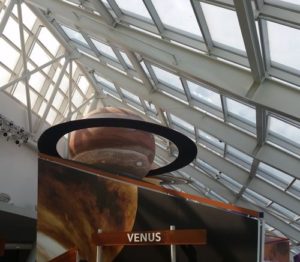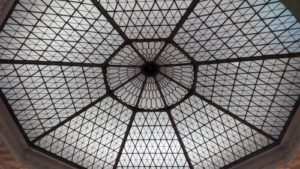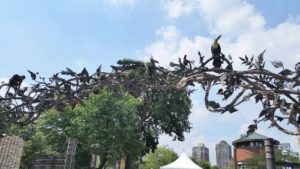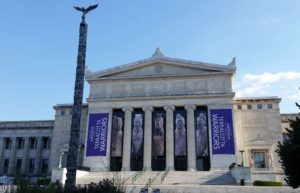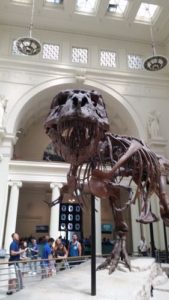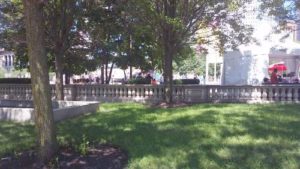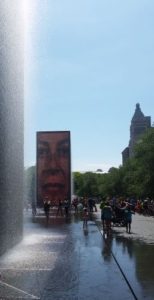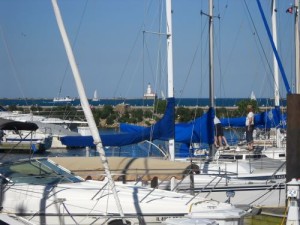The Field Museum of Natural History has always been my favorite museum. Some of my earliest memories are of the exhibits, and I swear that I had a dream about the Field Museum in which the artifacts were hung on pegboard hooks, like merchandise in a store, when I was very little.
First, a little (very little!) history. The Field Museum of Natural History was a sort of outgrowth of the World’s Columbian Exposition of 1893. The area which is now Jackson Park was the fairgrounds, and some of the prominent citizens of Chicago decided that this would be a good opportunity to start a hopefully someday-world-class museum. The original museum was called the Columbian Museum of Chicago, but they changed it to Field Columbian Museum a year later and then, still later, to the Field Museum of Natural History. The original displays were in one of the few permanent buildings constructed for the Exposition, the Palace of Fine Arts (which is now the Museum of Science and Industry). Construction on the current building took about three and a half years, from September 1917 to early 1921. The museum’s grand opening at its current home was on May 2, 1921. Also, apparently they changed the name from Field Museum of Natural History to Chicago Museum of Natural History for nearly 20 years. I had no idea that the name had been changed like that, so I guess you really do learn something new every day.
When you first enter the museum through the monumental entrance, you arrive in Stanley Field Hall, a vast, open two-story marble space that serves to set the tone for the museum. In my childhood, there were fountains at either end, and a cast of what used to be identified as an Albertosaurus, but which is apparently now identified as a Daspletosaurus (that’s a new one on me!). The Daspletosaurus used to be mounted in a very stiff, unnatural position, like it just noticed you taking his picture and being photographed makes it anxious. The bones of another animal lie at its feet. They have since removed the fountains and the Daspletosaurus has since been remounted in a more natural position and is now in the Dinosaur Hall in the Evolving Earth display (more on that later). The reigning dinosaur in Stanley Field Hall is now Sue, the Tyrannosaurus rex. Sue, being one of the most complete Tyrannosaurus rex skeletons ever found, is mostly real bones. Her head, however, was crushed, and is too heavy to mount besides, so they created an uncrushed cast and mounted it.
You can see Stanley Field Hall more or less as it looked in my childhood in the movie “The Relic.” The book that “The Relic” is based on was set in the American Museum of Natural History in New York City, so the rest of the interior shots were filmed in a studio, back before the American Museum of Natural History refused to let them film any scenes inside the museum. Fortunately, the Field Museum was fine with using their museum, so the exterior shots are of the Field Museum and the scenes in Stanley Field Hall were filmed there, but the rest of the interior scenes look like the American Museum of Natural History.
Much of the rest of Stanley Field Hall is the same as it was in my childhood. I cannot remember if the Brachiosaurus was in Stanley Field Hall during my childhood or if I am remembering other people’s photos of the room. Looking around it looks like I missed it entirely. It looks like they got the Brachiosaurus in 1994 and then had to remove it to make room for Sue. The original bones are in the back room and a cast of the fossil Brachiosaurus is now outdoors at the northwest corner of the museum.
One side of the rest of the main floor is taxidermied animals, from birds to mammals to sea creatures. The other side is primarily dedicated to displays about Native Americans. One little section is the upstairs of the Ancient Egypt display.
The basement, or “ground floor” as they call it on the map, used to be Ancient Egyptian and Ancient Roman and Etruscan artifacts, with a McDonald’s and some dioramas of prehistoric people. The original dioramas have since been determined to be historically inaccurate and been replaced by better researched dioramas of other prehistoric people. This was one of my favorite places in the museum, and not for the McDonald’s. I love learning about the ancient world, and Ancient Egypt has always been one of my favorites. I wouldn’t go back to then on a bet — I like antibiotics and anesthetics and being able to make my own decisions about my body and my life, despite being female.
There is the tomb of Unis-Ankh, the son of a lesser-known pharaoh on display in the museum. My mom and I used to disagree on whether it was a genuine tomb or not. The Field Museum website says, “The reconstruction is based around original pieces of the tomb, creating two authentic chamber rooms dating back to 2400 BC. “ So it’s possible that we were both right — parts of the rooms are genuine, but the rooms themselves are recreations. Also, in the basement, is a sort of mini-recreation of the Nile, and visitors can try using a shaduf, which is a bucket on a pole on a fulcrum, to remove water from the “river” and other activities.
The Ancient Egypt section seems to be right where I left it, but it looks like the Roman and Etruscan area has been been replaced by an exhibit called “the Underground World,” and the McDonald’s is now the Explorer Cafe. I glanced at the Explorer Cafe menu and at first I was all, “Pizza and chicken fingers. Blech.” But when I look farther, I see more variety including salads (they have a Mediterranean salad that sounds pretty good — what’s not to like about kalamata olives and feta cheese?), a third-pound burger, and an Italian beef sandwich. So that seems promising.
Upstairs is the Plants of the World display, the museum’s collections of artifacts from Asia, the Hall of Gems the Hall of Jades, and my other favorite place in the museum, the Evolving Earth exhibit. When I was a kid, there was no Evolving Earth display, just the Hall of Dinosaurs, a large sort of light-blue room filled with dinosaur skeletons. The largest of these is the Apatosaurus, which was known as the Brontosaurus for my early childhood, and which used to have the wrong head. When I was a young teenager, we went to the Field Museum after several years of not visiting and I took one look at it and said, “that’s not the same head.” No one believed me, but, thanks to the magic of the Internet I have been able to determine that I was right. They replaced the head, which had been from a Camarasaurus, with the correct one in the 1980s. Around the room, near the ceiling, were paintings of the evolution of the Earth, with particular focus on the dinosaurs, done by Charles R. Knight (Knight’s paintings were done when Apatosaurus had the wrong head, so it doesn’t look like the fossil on display now). I’ve always loved those paintings, and was surprised to find that, like another one of my favorite artists, Claude Monet, Knight had limited vision. While Monet lost his vision gradually over his life, Knight was legally blind from a young age and used special glasses to see well enough to paint.
The “Hall of Dinosaurs” is much diminished from what it used to be, though they still have the same dinosaurs. The room is about one-third the size, which necessitated putting them at different heights and linking them with ramps.
In my childhood there was a whole room devoted to meteorites, including one that fell in Illinois and passed through the roof of someone’s car. The section of car was on display as well, if I recall. That room is gone now, as well. I can find some evidence that they are working on some kind of fossil meteorite exhibit, but it does not show on the map that one can download from the Field Museum website.
The Field Museum is wheelchair accessible and there is handicapped parking available in the lot closest to the museum. If one is comfortable on public transportation, the Museum Campus stop of the Metra Electric line is handicap accessible, two bus lines have stops at the museum and it looks like the Red Line train stop at Roosevelt Road is also handicap accessible. It looks as though the East Entrance is the handicap accessible one. Getting to the East Entrance from public transportation may take some effort, since the Metra stop is several blocks away (Google Maps sends you down to 14th street and back up for some unknown reason), and I think the buses let out at the South Entrance, so plan accordingly.
I can find references to the Roman and Etruscan artifacts on the website, but cannot find it on the map for the life of me. I may have to call the museum to ask whether they have been retired to the back room or if they are on display somewhere and I just don’t see it on the map.
